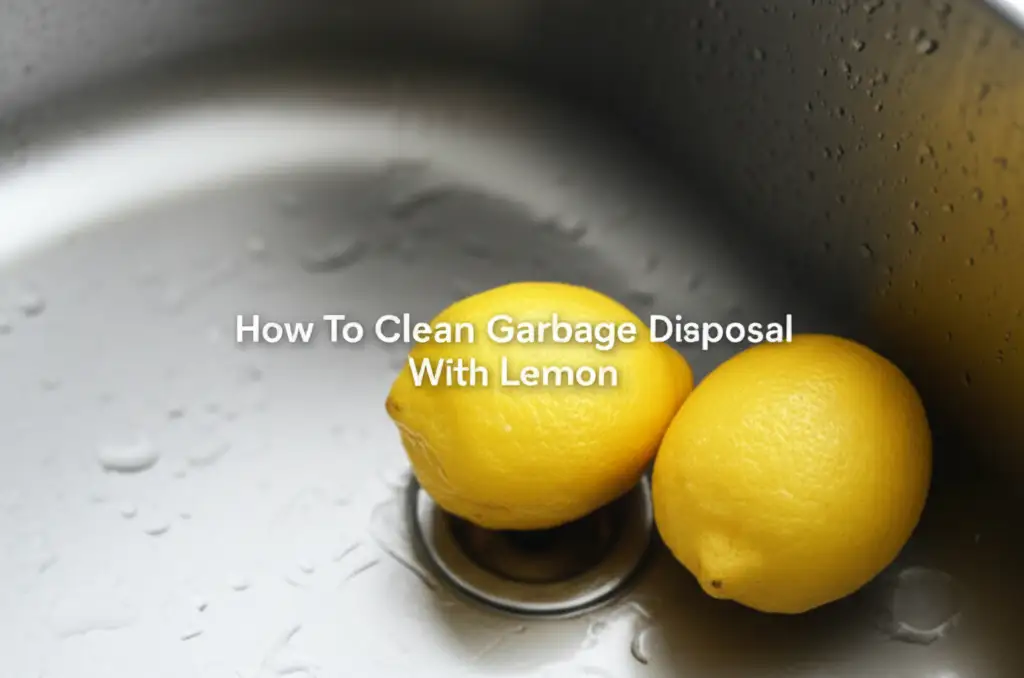· Home Cleaning · 15 min read
How To Clean Garbage Disposal With Lemon

Clean Your Garbage Disposal with Lemon: A Fresh Approach
Is a foul odor wafting from your kitchen sink? You are not alone. Many homeowners face the challenge of a smelly garbage disposal. Food particles and grease often accumulate inside, leading to unpleasant smells. However, there is a simple, natural, and highly effective solution. You can learn how to clean your garbage disposal with lemon. This method uses the power of natural citrus. It leaves your kitchen smelling fresh and clean.
This article provides a comprehensive guide. We will explore why your disposal smells bad. We will explain how lemon works its magic. You will get a step-by-step process for cleaning it. We will also discuss natural boosters. Finally, we will cover maintenance tips and safety precautions. You will have a fresh, odor-free kitchen disposal.
Takeaway
- Use Citrus: Lemon peels are effective for deodorizing and cleaning.
- Combine with Ice: Ice helps dislodge stuck food particles.
- Add Salt/Baking Soda: These enhance scrubbing and deodorizing actions.
- Run Cold Water: Always use cold water when running the disposal.
- Clean Regularly: Frequent cleaning prevents odor buildup.
Cleaning your garbage disposal with lemon involves grinding citrus peels and ice cubes with cold water. The lemon’s natural acidity and essential oils cut through grease and deodorize. The ice helps scrub the disposal’s internal components. This method removes odors and helps keep your kitchen fresh.
Why Your Garbage Disposal Needs Regular Cleaning
Your garbage disposal works hard. It grinds food waste, sending it down the drain. Over time, food particles build up inside. These particles can stick to the grinding components and splash guards. They also accumulate in the drain pipes. This accumulation creates an environment for bacteria to grow. These bacteria produce foul odors. This is why your kitchen might smell unpleasant.
Grease and food residues cling to surfaces. They trap more debris. This creates a cycle of odor production. Cleaning removes this buildup. It eliminates the source of the smell. A clean disposal also works more efficiently. It prevents clogs and extends the unit’s lifespan. Ignoring regular cleaning can lead to bigger problems. These problems include stubborn clogs or unit damage. A proactive approach saves time and money. It also keeps your kitchen smelling clean.
The Power of Lemon for Disposal Cleaning
Lemon offers a fantastic natural solution. Its effectiveness comes from several key properties. Lemons contain citric acid. This acid is a natural degreaser and disinfectant. It breaks down grease and food residue. It also kills odor-causing bacteria. This dual action cleans and sanitizes.
Lemon peels also contain essential oils. These oils release a fresh, pleasant scent. This scent replaces the foul odors. It does not just mask them. The grinding action of the disposal helps release these oils. The peels themselves act as a natural abrasive. They help scrub away grime from the blades and walls. This makes lemon an ideal cleaner for your disposal. It is safe for your plumbing. It is also environmentally friendly.
Step-by-Step Guide: How to Clean Your Garbage Disposal with Lemon
Cleaning your garbage disposal with lemon is simple. This process takes only a few minutes. It uses readily available ingredients. Follow these steps for a fresh, clean disposal.
Step 1: Gather Your Supplies
You will need a few common items. Get one or two whole lemons. You can use leftover lemon rinds from cooking. You also need ice cubes. Salt and baking soda are optional but recommended. A bottle brush is helpful for the splash guard.
Step 2: Prepare the Disposal
First, ensure safety. Turn off the disposal’s power switch. This switch is usually on the wall or under the sink. Never put your hand into the disposal. Use tongs if you need to retrieve anything. Rinse the disposal with cold water for about a minute. This flushes away loose debris.
Step 3: Clean the Splash Guard
The rubber splash guard often collects grime. Food splashes up and sticks to it. Lift each flap of the splash guard. Wipe underneath with a paper towel or sponge. You can use a bit of dish soap for tough grime. A small brush, like a bottle brush, works well for scrubbing. Pay attention to all sides of the rubber. This removes visible residue.
Step 4: Add Ice and Lemon
Fill the disposal with about two cups of ice cubes. The ice helps dislodge food particles. It also sharpens the grinding plates. Next, add the lemon. Cut whole lemons into quarters. You can also use a handful of lemon peels. Drop the lemon pieces into the disposal on top of the ice.
Step 5: Incorporate Optional Boosters
For a deeper clean, add natural boosters. Sprinkle half a cup of baking soda into the disposal. Baking soda is a powerful deodorizer. It absorbs odors and helps lift grime. Then, add a quarter cup of coarse salt. Salt provides extra scrubbing power. It works with the ice to scour the interior. These additions create a more thorough cleaning action. For other effective natural cleaning methods, consider how vinegar and baking soda work together for various tasks, which you can learn more about by reading about how to clean with vinegar and baking soda.
Step 6: Grind the Mixture
Turn on the cold water to a slow stream. Flip the disposal’s power switch back on. Let the disposal run until all the ice and lemon are ground up. You will hear the grinding sound change. It will become quieter when the process is complete. This usually takes about 30 seconds to a minute. The lemon oils release and neutralize odors. The ice and salt scrub the inside.
Step 7: Final Rinse
Once the grinding stops, turn off the disposal. Let the cold water run for another 30 seconds. This flushes all the remaining particles down the drain. It ensures no residue is left behind. Your disposal should now smell fresh. It should also operate more smoothly. This simple process provides a natural and effective clean.
Beyond Lemon: Enhancing the Clean with Natural Boosters
While lemon is powerful, combining it with other natural ingredients enhances the cleaning process. These boosters tackle different aspects of disposal cleaning. They provide a more comprehensive result.
Baking Soda: The Odor Absorber
Baking soda is a renowned deodorizer. It neutralizes acidic and basic odors. When you add it to your disposal, it absorbs trapped smells. It also acts as a mild abrasive. This helps scrub away grime from the internal components. For example, when you are looking to clean tough stains in your shower, baking soda is a great option. You can find out more about it by reading how to clean your shower with baking soda. Sprinkle half a cup into the disposal. Let it sit for 10-15 minutes before adding lemon and ice. This allows it to work on stubborn odors. It also helps loosen any stuck-on food.
Vinegar: The Disinfectant and Degreaser
White vinegar is another excellent natural cleaner. It contains acetic acid. This acid is effective at breaking down grease. It also kills bacteria. For a deeper clean, you can combine vinegar with baking soda. Sprinkle baking soda into the disposal first. Then, slowly pour in half a cup of white vinegar. The mixture will fizz and foam. This reaction creates a powerful scrubbing action. Let it sit for 15-20 minutes. After that, add your lemon and ice. Grind the mixture with cold water. Vinegar is also great for other kitchen items. You can use it to clean glass stovetops. Learn more about how to clean a glass stovetop with vinegar.
Ice: The Grinding Enhancer
Ice cubes play a crucial role. They are not just for cooling drinks. When ground in the disposal, ice helps sharpen the blades. It also scrapes away food particles. These particles cling to the grinding chamber walls. Using a generous amount of ice ensures a thorough scrubbing action. Combine ice with salt for even more abrasion. The cold temperature also helps solidify any grease. This makes it easier for the disposal to grind it away. This combination ensures a mechanically clean unit. It works well with the chemical action of lemon.
Salt: The Natural Scrubber
Coarse salt, like rock salt or kosher salt, adds extra abrasive power. When combined with ice and lemon, it acts like a natural scouring agent. It helps scrub away stubborn grime and buildup. Add about a quarter cup of salt to your disposal along with the ice. The salt particles enhance the friction. This dislodges trapped debris more effectively. This creates a very thorough cleaning action. This is similar to how you might use salt as an abrasive for other tough cleaning jobs.
By using these natural boosters with lemon, you create a powerful cleaning regimen. This tackles odors, grease, and stubborn food particles. It keeps your garbage disposal in top condition. You avoid harsh chemicals. You maintain a fresh and clean kitchen environment.
Troubleshooting Common Garbage Disposal Issues
Even with regular cleaning, you might encounter issues. Some problems require specific solutions. Do not worry. Most common issues have simple fixes.
Persistent Odors
If the smell remains after cleaning with lemon, it suggests a deeper issue. The odor might come from the drain pipes, not just the disposal. Food particles can get stuck further down the line. Try a baking soda and vinegar flush. Pour one cup of baking soda into the drain. Follow it with two cups of white vinegar. Let it sit for at least 30 minutes, or even overnight. Then, flush with hot water. For a very persistent smell, a plumber may need to inspect the drain lines. Sometimes, the issue is not the disposal itself. It can be a drain pipe problem.
Minor Clogs
A slow draining disposal indicates a minor clog. Never use chemical drain cleaners in your disposal. These can damage the unit or pipes. First, ensure the power is off. Use a flashlight to look into the drain. See if you can spot any obvious obstructions. Use tongs or pliers to carefully remove any visible items. Do not put your hand inside. If no obstruction is visible, try the baking soda and vinegar method. Another option is a plunger. Fill the sink with a few inches of water. Place the plunger over the drain. Pump vigorously a few times. This creates pressure that can dislodge the clog. Remember, if the clog is severe or recurs often, consult a professional.
Unit Jams
Sometimes the disposal hums but does not grind. This means it is jammed. First, turn off the power. Look into the drain with a flashlight. Identify the object causing the jam. Often, it is a piece of silverware or a bone. Use tongs or pliers to carefully remove the object. Never use your hand. If you cannot see the object, look for a small hex wrench opening on the bottom of the disposal unit. Insert the wrench and turn it back and forth. This manually rotates the grinding plate. It frees the jam. There is also a red reset button on the bottom of the disposal. Push it after freeing the jam. Then, turn the power back on and test the unit. If it still does not work, call a professional.
Addressing these issues promptly prevents them from worsening. Regular cleaning helps prevent many problems. It keeps your garbage disposal working efficiently.
Maintaining a Fresh Disposal: Tips for Regular Upkeep
Regular maintenance is key. It prevents odors and clogs. It keeps your disposal running smoothly. Here are simple habits for daily and weekly upkeep.
Run Cold Water Regularly
Always run cold water when using the disposal. Continue running water for 15-20 seconds after you turn off the disposal. This ensures all food particles flush completely. It prevents food from sitting and rotting inside the unit. Cold water also solidifies grease. This makes it easier for the disposal to grind. Hot water melts grease. This can cause it to cling to pipes. This creates clogs.
Grind Small Batches
Avoid overwhelming your disposal. Feed food waste in small amounts. Grind small batches rather than one large load. This helps the motor work efficiently. It also ensures all food gets thoroughly ground. Overloading the disposal can lead to jams. It can also strain the motor. This reduces the unit’s lifespan.
Avoid Certain Foods
Some foods are not disposal-friendly. Avoid fibrous materials like celery stalks, corn husks, and artichokes. These can tangle around the grinding plates. They can also create stringy clogs. Do not put potato peels or banana peels down the disposal. These create a thick paste that can block drains. Never put grease, oil, or fat down the disposal. They solidify and coat pipes. This causes severe clogs over time. Coffee grounds and eggshells are also problematic. They create a fine sludge that can build up. Knowing what not to put in is as important as knowing how to clean.
Regular Lemon and Ice Cleaning
Make the lemon and ice cleaning a routine. Do it once a week or bi-weekly. This prevents odor buildup. It also keeps the grinding components clean and sharp. Consistency is important for maintenance. It keeps your disposal fresh. It ensures its longevity.
Clean the Splash Guard Frequently
The rubber splash guard is a common source of odors. Food particles stick to it. Lift its flaps and clean underneath regularly. Use a brush and some dish soap. This prevents grime from accumulating. A clean splash guard means a cleaner kitchen sink area. By following these simple maintenance tips, you can enjoy a fresh and efficient garbage disposal. This saves you time and trouble in the long run.
Safety First: Important Precautions When Cleaning Your Disposal
Safety should always be your top priority. A garbage disposal is a powerful appliance. It has sharp components. Taking proper precautions prevents accidents.
Always Turn Off the Power
This is the most critical rule. Before putting your hand or any tool into the disposal, turn off the power. The switch is usually on the wall or under the sink. You do not want the unit to accidentally activate. Even if you think it is off, double-check. This prevents serious injuries. Never take chances with moving parts.
Never Put Your Hand Inside
Under no circumstances should you put your hand inside the disposal. Even when the power is off, the grinding plates are sharp. They can cause cuts. Use tongs, pliers, or a long-handled tool to retrieve objects. These tools keep your hands safe and out of the danger zone. They allow you to manipulate items without risk.
Avoid Harsh Chemicals
Chemical drain cleaners are dangerous for disposals. They contain corrosive substances. These can damage the rubber and metal components of your unit. They can also harm your plumbing pipes. The fumes are toxic. Stick to natural cleaning methods like lemon, ice, baking soda, and vinegar. These are safe and effective. They do not pose a risk to your health or your plumbing system.
Use Cold Water When Operating
Always run cold water when the disposal is on. Cold water helps solidify grease. This allows the disposal to grind it more effectively. Hot water melts grease. This can cause it to cling to pipes. This leads to clogs. Running cold water also helps flush away ground food particles. This prevents buildup.
Be Mindful of What You Grind
Do not put non-food items into the disposal. This includes metal, plastic, glass, or paper. These can damage the grinding plates or motor. Stick to approved food waste. Avoid tough, fibrous items. This prevents jams and extends the life of your unit. By following these safety precautions, you protect yourself. You also protect your disposal. You ensure a safe and clean kitchen environment.
Frequently Asked Questions (FAQ)
How often should I clean my garbage disposal with lemon?
You should aim to clean your garbage disposal with lemon and ice at least once a week. If you use your disposal heavily, or if you notice odors developing, increase the frequency to twice a week. Regular cleaning prevents bad smells and keeps the unit running efficiently.
Can I use other citrus fruits instead of lemon?
Yes, you can absolutely use other citrus fruits. Oranges, limes, and grapefruits all contain similar citric acid and essential oils. Their peels work just as effectively as lemon peels for deodorizing and cleaning your garbage disposal. Use what you have readily available.
Does lemon remove tough clogs in the disposal?
Lemon alone does not remove tough clogs. It helps break down grease and small food particles. It also deodorizes. For severe clogs, you might need to use a plunger, or a baking soda and vinegar mixture. For very stubborn blockages, professional help might be necessary.
Is lemon safe for my plumbing pipes?
Yes, lemon is perfectly safe for your plumbing pipes. Its natural acidity is mild. It helps clean without causing damage. Unlike harsh chemical cleaners, lemon is biodegradable. It will not corrode your pipes or harm the environment. It is an eco-friendly cleaning solution.
What if the smell persists after cleaning with lemon?
If the smell persists, the odor might originate deeper in the drain pipes or from food stuck on the splash guard. Clean the splash guard thoroughly. Try a baking soda and vinegar flush for the drain. If problems continue, consider a professional drain inspection.
Can I use just ice to clean my garbage disposal?
You can use just ice, and it helps to some extent. Ice alone will scrape the grinding components and sharpen the blades. However, it does not provide the deodorizing or degreasing power of lemon. For best results, combine ice with lemon, and consider adding baking soda or salt.
Conclusion
A clean, fresh-smelling kitchen starts with a well-maintained garbage disposal. Learning how to clean your garbage disposal with lemon is a simple, effective, and natural solution. This method harnesses the power of citric acid and essential oils. It tackles odors, breaks down grime, and leaves a pleasant scent. It also helps keep your unit running smoothly.
Regular use of lemon, combined with ice and other natural boosters like baking soda or salt, creates a powerful cleaning routine. Remember to always prioritize safety. Turn off the power before cleaning. Never put your hands inside the unit. By adopting these habits, you will enjoy a consistently fresh kitchen. Make cleaning your garbage disposal a part of your regular kitchen maintenance. You will appreciate the fresh difference. Start your natural cleaning journey today.
- garbage disposal cleaning
- lemon cleaning
- natural kitchen cleaning
- odor removal
- sink maintenance
- citrus cleaner




